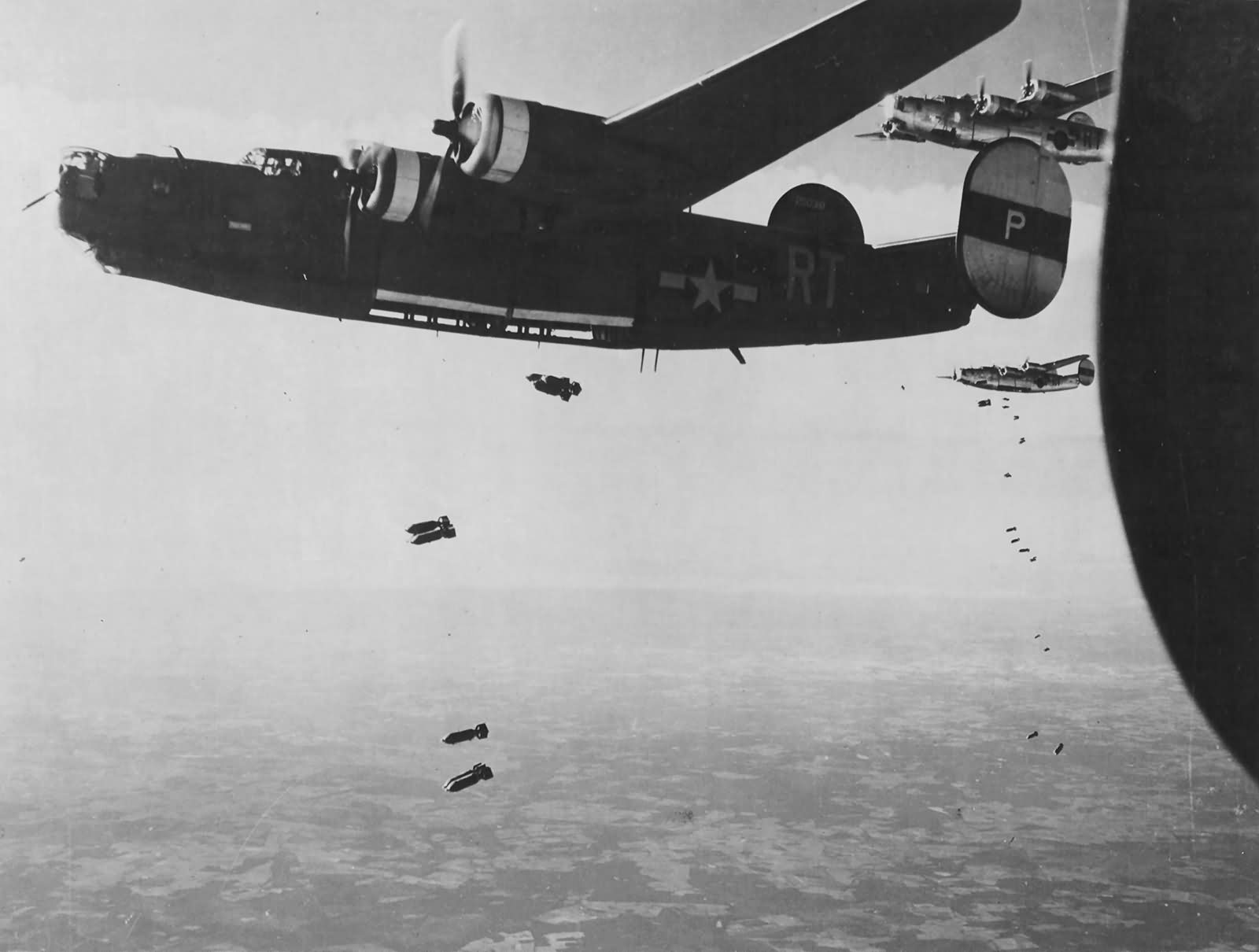The 446th Bomb Group (Heavy), also known as the “Bungay Buckeroos”, was a significant unit of the Eighth Air Force during World War II, operating the B-24 Liberator bomber.
Overview and Command Assignments
- Assigned to Eighth Air Force: November 1943 – July 1945
- Wing & Command Assignments:
- VIII Bomber Command (BC), 2nd Bombardment Division (BD), 20th Combat Bomb Wing (CBW): 4 November 1943
- 2nd BD, 20th CBW: 8 January 1944
- 2nd Air Division (AD), 20th CBW: 1 January 1945
Component Squadrons
- 704th Bombardment Squadron (H): Squadron code FL
- 705th Bombardment Squadron (H): Squadron code HN
- 706th Bombardment Squadron (H): Squadron code RT
- 707th Bombardment Squadron (H): Squadron code JU
Combat Aircraft
- B-24H Liberator: (From blocks 1-CF and FO)
- B-24J, B-24L, and B-24M Liberators
Station
- Bungay, England: 4 November 1943 – 5 July 1945
Group Commanding Officers (COs)
- Col. Jacob J. Brogger: 27 September 1943 – 22 September 1944 (Wounded in Action on 18 September 1944)
- Col. Troy W. Crawford: 23 September 1944 – 4 April 1945 (Taken POW)
- Lt. Col. William A. Schmidt: 4 April 1945 – Unknown
Mission Details
- First Mission: 16 December 1943
- Last Mission: 25 April 1945
- Total Missions: 273
- Total Credit Sorties: 7,259
- Total Bomb Tonnage: 16,819 tons
- Aircraft Missing in Action (MIA): 58
- Other Operational Losses: 28
- Enemy Aircraft Claims: 34 destroyed, 11 probably destroyed, 8 damaged
Major Awards
- None
Claims to Fame
- D-Day Participation: Led the Eighth Air Force and 2nd Bombardment Division on the first heavy bomber mission of D-Day (6 June 1944).
- “Ronnie”: Believed to be the first Eighth Air Force B-24 to fly 100 missions.
- Notable Squadron Records:
- 706th Bomb Squadron: Flew 62 consecutive missions without loss.
- 707th Bomb Squadron: Flew 68 consecutive missions without loss.
History
- Activated: 1 April 1943 at Davis-Monthan Field, Arizona, where the initial assembly took place.
- Training Locations:
- Alamogordo, New Mexico: Moved on 6 June 1943 but immediately relocated to Lowery Army Air Base (AAB), Colorado, where training was completed.
- Deployment:
- Ground echelon left on 18/19 October 1943 for Camp Shanks, New York, and embarked on the Queen Mary on 25 October 1943, arriving in Clyde on 2 November 1943.
- Air echelon departed Lowery AAB between 20-26 October 1943 for Lincoln AAB, Nebraska. They then flew to the UK via the southern route (Florida, Puerto Rico, Brazil, Dakar, Marrakesh). During the journey, one aircraft was lost on the Puerto Rico leg, and another was shot down by enemy aircraft when it was off course over France.
Aircraft Markings and Color Schemes
B-24H/J/L/M Liberators (November 1943 – July 1945)
- Original Paint Scheme: Dark Olive Drab and Neutral Gray factory finish.
- Group Marking:
- Circle H: Applied to the vertical tail as a 69-inch white disc with a 36-inch high Insignia Blue letter “H.” On the upper surface of the right wing, the marking was a 78-inch diameter white disc with a 48-inch high blue letter “H.” On replacement aircraft, the letter was often painted in black.
- The tail number, often obscured by the Circle H, was repainted below it in yellow. Directly below the number, a 24-inch high individual aircraft call-letter was painted in yellow.
- Squadron Codes and Call Letters:
- 704th Bomb Squadron: Did not use a bar with the call-letter.
- 705th Bomb Squadron: Used a bar below the call-letter.
- 706th Bomb Squadron: Used a bar above the call-letter.
- 707th Bomb Squadron: Used two bars, one above and one below the call-letter.
- Call-letter Bars: These yellow bars were added at the end of January 1944, a few weeks after the call-letters were painted on, and were 1½ inches thick, much thinner than commonly used on 2nd Bomb Division aircraft.
- Marking Changes in March 1944:
- Squadron code letters, 48 inches high, were painted on the rear fuselage aft of the waist gun positions in pale grey (Sky).
- 704th Bomb Squadron: FL
- 705th Bomb Squadron: HN
- 706th Bomb Squadron: RT
- 707th Bomb Squadron: JU
- Natural Metal-Finish B-24Js: First received in April 1944, had code letters painted black with the Group device (Circle H) white on black.
- Squadron code letters, 48 inches high, were painted on the rear fuselage aft of the waist gun positions in pale grey (Sky).
- High-Visibility Color Markings (May 1944):
- The outer facing sides of the vertical tail were painted Identification Yellow with a 36-inch wide black horizontal stripe positioned centrally.
- A 24-inch high yellow call-letter was carried on the black stripe, but the bar signs were discontinued.
- From the summer of 1944, call-letters for replacement B-24s were selected from the whole alphabet range excluding the letter “I.”
- Engine cowlings, between the cowl ring and the cooling shutters, were painted with squadron colors:
- 704th Bomb Squadron: Red
- 705th Bomb Squadron: Yellow
- 706th Bomb Squadron: White
- 707th Bomb Squadron: Dark Blue
- Late Summer 1944: The Group’s Pathfinder B-24s were given a black ring marking, superimposed centrally on the existing tail markings. Where the ring passed through the black band, it was rendered in yellow. The overall diameter was 88 inches, the ring being 8 inches thick, and the inner diameter was 72 inches.
